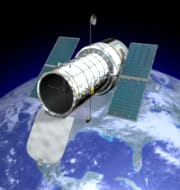NASA’s Hubble telescope spots ocean on Jupiter's moon Ganymede
NASA’s Hubble Space Telescope has spotted massive saltwater ocean under the icy crust of Jupiter’s largest moon Ganymede.
Scientists believe that this finding could potentially support life. Hubble Space Telescope’s finding was published in the Journal of Geophysical Research: Space Physics.
The finding was based on the results obtained after analyzing Ganymede’s magnetic field and aurorae created and controlled by it and its interaction with Jupiter’s magnetic field.
Scientists estimate that
- This ocean is 100 kms thick.
- 10 times deeper than Earth’s oceans.
- It is buried under a 150-kilometre crust of mostly ice.
In 1970s, for first time scientists had suggested that ocean is present inside Ganymede based on its models. NASA’s Galileo mission also had provided first evidence of ocean in Ganymede after measuring its magnetic field in 2002.
About Ganymede
- Ganymede is the largest moon in our solar system. It is also the only moon with its own magnetic field.
- The magnetic field causes aurorae, which are ribbons of glowing, hot electrified gas, in regions circling the north and south poles of the moon.
Month: Current Affairs - March, 2015


